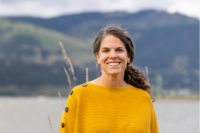Pollution Prevention Curriculum Launches

Our virtual curriculum is here!
My job is incredible: I inspire kids to learn about and protect clean water, in classrooms and on the river. But this year, as students are distance learning or cautiously making their way back to classrooms, I had to get creative to keep kids excited to learn about the Columbia and how they can restore clean water and thriving habitat.
Columbia Riverkeeper developed four virtual science units that tackle important environmental issues and inspire action. Kids can work on the units at home on their own, or teachers can facilitate learning in a classroom or online. The lessons, experiments, and hands-on activities use supplies and materials you likely already have.
Can you help us spread the word?
Share our new curriculum on social media (Twitter, Facebook, Instagram) or share this blog post with teachers and parents you know. Click here to check out the curriculum.
Science units are tailored for sixth through eighth grade and taught to middle school science standards, but could easily be adapted for other ages. Our lessons focus on pollution prevention and the engaging topics covered include: household contaminants, stormwater, riparian zones, and microplastics. Students will learn to define environmental problems, evaluate evidence, and develop their own solutions.
With your help, we can make learning fun and inspire the next generation of river protectors.
Welcome to Columbia Riverkeeper’s Hub for Teaching Pollution Prevention to Middle School Students.
For Immediate Release
Columbia Riverkeeper Looks to the River to Inspire Learning, Introduces New Pollution Prevention Curriculum for Hybrid Education
To adapt to flexible and hybrid learning models emerging from a year centered on public health response, Columbia Riverkeeper developed four virtual science units that tackle important environmental issues and inspire action. Kids can work on the units at home on their own, or teachers can facilitate learning in a classroom or online. The lessons, experiments, and hands-on activities use supplies and materials can be found in most homes.
“The Columbia River has the ability to inspire education every day and should play a vital role in connecting our students to innovative and engaging forms of learning,” shared Lorri Epstein, Columbia Riverkeeper’s Water Quality Director. “We hope this eases the pressure for teachers, parents, and students by centering the natural environment as one of our best and most accessible resources for education.”
The curriculum, supported by a grant from the U.S. Environmental Protection Agency, is tailored for sixth through eighth grade and taught to middle school science standards, but could easily be adapted for other ages. Students will learn to define environmental problems, evaluate evidence, and develop their own solutions. The lessons focus on pollution prevention and engaging topics in four areas:
- Unit 1: Household Contaminants
- Unit 2: Stormwater
- Unit 3: Riparian Zones
- Unit 4: Plastics
Columbia Riverkeeper intends to update the curriculum seasonally and will post updates directly on the website. The open-source curriculum is designed for engagement along the Columbia River, but can be adapted to the proximity of teachers and learners. For example, one of the activities in the Unit 3: Riparian Zones calls to visit Nichols Natural Area in Hood River. This location could easily be modified to another habitat restoration area.
For any questions regarding the curriculum, contact Columbia Riverkeeper’s Water Quality Director, Lorri Epstein at lorri@columbiariverkeeper.org.


